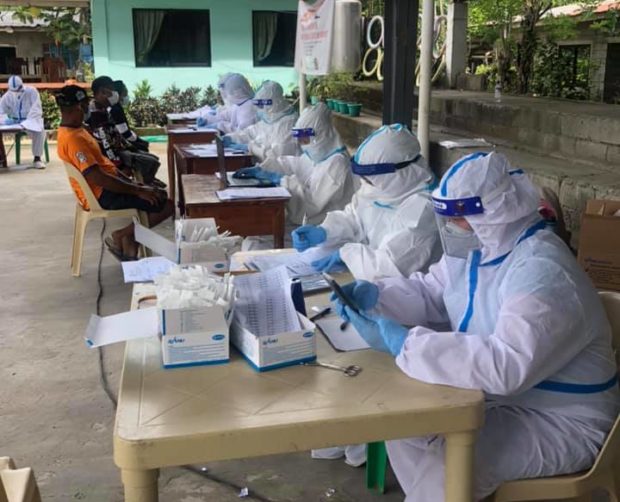ICU occupancy in Ilocos Region at critical risk, 5 other regions at high risk

Health workers in Dingras town, Ilocos Norte province conduct coronavirus tests for residents amid a surge in COVID-19 cases. PHOTO FROM DINGRAS LGU
MANILA, Philippines — The occupancy for intensive care unit (ICU) beds is at critical risk in the Ilocos Region and high risk in five other regions, the Department of Health (DOH) said Thursday.
Data presented by Dr. Alethea De Guzman, OIC-Director of the DOH Epidemiology Bureau, in an online media forum showed that the ICU utilization in Ilocos Region is at 86 percent, but the overall health care utilization rate (HCUR) is 46 percent.
Meanwhile, ICU utilization is 79 percent in Central Visayas, and 71 percent in Cordillera Administrative Region (CAR), Cagayan Valley, Calabarzon, and Central Luzon.
Overall HCUR, which covers other types of hospital beds, is 69 percent in Central Visayas, 63 percent in CAR, Cagayan Valley, and Calabarzon, and 52 percent in Central Luzon.
The DOH rates the risk level for HCUR and ICU occupancy as safe if it is less than 60 percent, moderate if it is 60 percent to below 70 percent, high risk if it is 70 percent to below 85 percent, and critical if it is 85 percent and above.
Article continues after this advertisementOn COVID-19 cases, all regions in the country are at moderate risk, except for Calabarzon, Central Luzon, and Bicol Region that are all low risk.
Article continues after this advertisementMeanwhile, the average daily attack rate (ADAR) is still at high risk but slowly decreasing in CAR, Metro Manila, and Cagayan Valley.
ADAR is the average number of new cases per day over a two-week period, divided by a certain population in an area. The DOH computes the ADAR per 100,000 population.
ADAR is considered high risk if it is more than seven per 100,000 population. A higher ADAR means a higher risk of getting infected.
According to De Guzman, 11 regions, mostly in Visayas and Mindanao, were found to have positive two-week growth rates for new COVID-19 cases. These are Caraga, Bangsamoro Autonomous Region in Muslim Mindanao, and Regions 9, 6, 4B, 10, 1, 12, 7, 11, and 8.
“Ito ang mga rehiyon na ang kanilang two-week growth rate ay positibo, meaning mas marami tayong nahahanap na kaso in the last two weeks. Kasabay noon ay ang pagtaas ng kanilang ADAR,” she added.
(These are the regions that have a positive two-week growth rate, meaning we are detecting more cases in the last two weeks. Their ADAR is increasing simultaneously.)
The two-week growth rate measures the growth of cases from the previous two weeks as compared to the data from three to four weeks ago.
The country now has a total of 48,109 active COVID-19 cases, including the additional 6,483 coronavirus cases added to the count on Thursday.